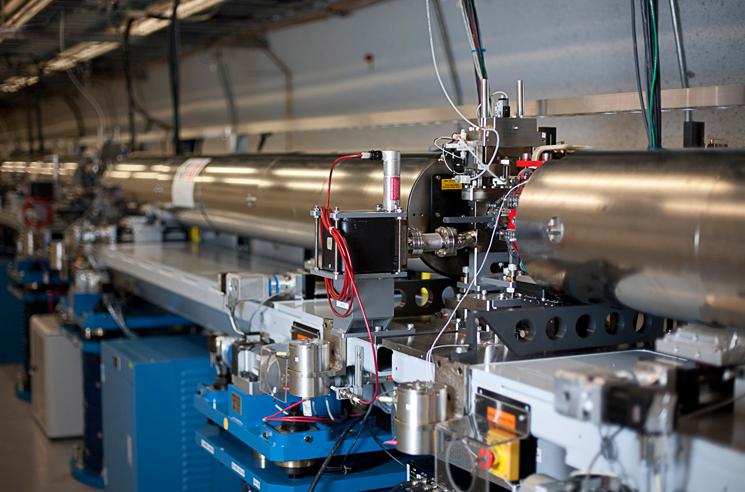|
Bhabha Scattering
In quantum electrodynamics, Bhabha scattering is the electron-positron scattering process: ::e^+ e^- \rightarrow e^+ e^- There are two leading-order Feynman diagrams contributing to this interaction: an annihilation process and a scattering process. Bhabha scattering is named after the Indian physicist Homi J. Bhabha. The Bhabha scattering rate is used as a luminosity monitor in electron-positron colliders. Due to crossing symmetry, Bhabha scattering has the same amplitude as Møller scattering. Differential cross section To leading order, the spin-averaged differential cross section for this process is ::\frac = \frac \left( u^2 \left( \frac + \frac \right)^2 + \left( \frac \right)^2 + \left( \frac \right)^2 \right) \, where ''s'',''t'', and ''u'' are the Mandelstam variables, \alpha is the fine-structure constant, and \theta is the scattering angle. This cross section is calculated neglecting the electron mass relative to the collision energy and including only the contri ... [...More Info...] [...Related Items...] OR: [Wikipedia] [Google] [Baidu] |
Feynman Diagrams
In theoretical physics, a Feynman diagram is a pictorial representation of the mathematical expressions describing the behavior and interaction of subatomic particles. The scheme is named after American physicist Richard Feynman, who introduced the diagrams in 1948. The calculation of probability amplitudes in theoretical particle physics requires the use of large, complicated integrals over a large number of variable (mathematics), variables. Feynman diagrams instead represent these integrals graphically. Feynman diagrams give a simple visualization of what would otherwise be an arcane and abstract formula. According to David Kaiser (physicist), David Kaiser, "Since the middle of the 20th century, theoretical physicists have increasingly turned to this tool to help them undertake critical calculations. Feynman diagrams have revolutionized nearly every aspect of theoretical physics." While the diagrams apply primarily to quantum field theory, they can be used in other areas o ... [...More Info...] [...Related Items...] OR: [Wikipedia] [Google] [Baidu] |
Belle Experiment
The Belle experiment was a particle physics experiment conducted by the Belle Collaboration, an international collaboration of more than 400 physicists and engineers, at the High Energy Accelerator Research Organisation ( KEK) in Tsukuba, Ibaraki Prefecture, Japan. The experiment ran from 1999 to 2010. The Belle detector was located at the collision point of the asymmetric-energy electron–positron collider, KEKB. Belle at KEKB together with the BaBar experiment at the PEP-II accelerator at SLAC were known as the B-factories as they collided electrons with positrons at the center-of-momentum energy equal to the mass of the (4S) resonance which decays to pairs of B mesons. The Belle detector was a hermetic multilayer particle detector with large solid angle coverage, vertex location with precision on the order of tens of micrometres (provided by a silicon vertex detector), good distinction between pions and kaons in the momenta range from 100 MeV/c to few GeV/c (provi ... [...More Info...] [...Related Items...] OR: [Wikipedia] [Google] [Baidu] |
Beijing Electron–Positron Collider II
The Beijing Electron–Positron Collider II (BEPC II) is a Chinese electron–positron collider, a type of particle accelerator, located in Shijingshan District, Beijing, People's Republic of China. It has been in operation since 2008 and has a circumference of 240.4 m. It was intended as a charm factory and continues the role of CLEO-c detector. The center of mass energy can go up to 4.6 GeV with a design luminosity of 1033 cm−2·s−1. Operations began in summer 2008 and the machine has run at multiple energies. History The construction of the original Beijing Electron Positron Collider was approved in 1983, as China was emerging from the Cultural Revolution, based on a proposal developed by Xie Jialin, who went on to oversee the construction of the machine. The construction of this collider was considered so important that then vice-premier Deng Xiaoping attended the groundbreaking in 1984 and returned in 1988 as the machine neared operation. The ori ... [...More Info...] [...Related Items...] OR: [Wikipedia] [Google] [Baidu] |
Stanford Large Detector
SLAC National Accelerator Laboratory, originally named the Stanford Linear Accelerator Center, is a federally funded research and development center in Menlo Park, California, United States. Founded in 1962, the laboratory is now sponsored by the United States Department of Energy and administrated by Stanford University. It is the site of the Stanford Linear Accelerator, a 3.2 kilometer (2-mile) linear accelerator constructed in 1966 that could accelerate electrons to energies of 50 GeV. Today SLAC research centers on a broad program in atomic and solid-state physics, chemistry, biology, and medicine using X-rays from synchrotron radiation and a free-electron laser as well as experimental and theoretical research in elementary particle physics, accelerator physics, astroparticle physics, and cosmology. The laboratory is under the programmatic direction of the United States Department of Energy Office of Science. History Founded in 1962 as the Stanford Linear Accelerator ... [...More Info...] [...Related Items...] OR: [Wikipedia] [Google] [Baidu] |
Luminosity (scattering Theory)
In scattering theory and accelerator physics, luminosity (''L'') is the ratio of the number of events detected (''dN'') in a certain period of time (''dt'') to the cross-section (''σ''): : L = \frac\frac. It has the dimensions of events on time on area, and is usually expressed in the cgs units of cm−2· s−1 or the non-SI units of b−1·s−1. In practice, ''L'' is dependent on the particle beam parameters, such as beam width and particle flow rate, as well as the target properties, such as target size and density. A related quantity is integrated luminosity (''L''int), which is the integral of the luminosity with respect to time: : L_\mathrm = \int L \ dt. The luminosity and integrated luminosity are useful values to characterize the performance of a particle accelerator. In particular, all collider experiments aim to maximize their integrated luminosities, as the higher the integrated luminosity, the more data is available to analyze. Examples of collider lum ... [...More Info...] [...Related Items...] OR: [Wikipedia] [Google] [Baidu] |
Feynman Slash Notation
In the study of Dirac fields in quantum field theory, Richard Feynman introduced the convenient Feynman slash notation (less commonly known as the Dirac slash notation). If ''A'' is a covariant vector (i.e., a 1-form), : \ \stackrel\ \gamma^0 A_0 + \gamma^1 A_1 + \gamma^2 A_2 + \gamma^3 A_3 where ''γ'' are the gamma matrices. Using the Einstein summation notation, the expression is simply : \ \stackrel\ \gamma^\mu A_\mu. Identities Using the anticommutators of the gamma matrices, one can show that for any a_\mu and b_\mu, :\begin = a^\mu a_\mu \cdot I_4 = a^2 \cdot I_4 \\ + = 2 a \cdot b \cdot I_4. \end where I_4 is the identity matrix in four dimensions. In particular, :^2 = \partial^2 \cdot I_4. Further identities can be read off directly from the gamma matrix identities by replacing the metric tensor with inner products. For example, :\begin \gamma_\mu \gamma^\mu &= -2 \\ \gamma_\mu \gamma^\mu &= 4 a \cdot b \cdot ... [...More Info...] [...Related Items...] OR: [Wikipedia] [Google] [Baidu] |
Dirac Spinor
In quantum field theory, the Dirac spinor is the spinor that describes all known fundamental particles that are fermions, with the possible exception of neutrinos. It appears in the plane-wave solution to the Dirac equation, and is a certain combination of two Weyl spinors, specifically, a bispinor that transforms "spinorially" under the action of the Lorentz group. Dirac spinors are important and interesting in numerous ways. Foremost, they are important as they do describe all of the known fundamental particle fermions in nature; this includes the electron and the quarks. Algebraically they behave, in a certain sense, as the "square root" of a vector. This is not readily apparent from direct examination, but it has slowly become clear over the last 60 years that spinorial representations are fundamental to geometry. For example, effectively all Riemannian manifolds can have spinors and spin connections built upon them, via the Clifford algebra. The Dirac spinor is specific to t ... [...More Info...] [...Related Items...] OR: [Wikipedia] [Google] [Baidu] |
Crossing Symmetry
In quantum field theory, a branch of theoretical physics, crossing is the property of scattering amplitudes that allows antiparticles to be interpreted as particles going backwards in time. Crossing states that the same formula that determines the S-matrix elements and scattering amplitudes for particle \mathrm to scatter with \mathrm and produce particle \mathrm and \mathrm will also give the scattering amplitude for \mathrm+\bar+\mathrm to go into \mathrm, or for \bar to scatter with \mathrm to produce \mathrm+\bar. The only difference is that the value of the energy is negative for the antiparticle. The formal way to state this property is that the antiparticle scattering amplitudes are the analytic continuation of particle scattering amplitudes to negative energies. The interpretation of this statement is that the antiparticle is in every way a particle going backwards in time. History Murray Gell-Mann and Marvin Leonard Goldberger introduced crossing symmetry in 1954. Cr ... [...More Info...] [...Related Items...] OR: [Wikipedia] [Google] [Baidu] |
Bhabha Scattering
In quantum electrodynamics, Bhabha scattering is the electron-positron scattering process: ::e^+ e^- \rightarrow e^+ e^- There are two leading-order Feynman diagrams contributing to this interaction: an annihilation process and a scattering process. Bhabha scattering is named after the Indian physicist Homi J. Bhabha. The Bhabha scattering rate is used as a luminosity monitor in electron-positron colliders. Due to crossing symmetry, Bhabha scattering has the same amplitude as Møller scattering. Differential cross section To leading order, the spin-averaged differential cross section for this process is ::\frac = \frac \left( u^2 \left( \frac + \frac \right)^2 + \left( \frac \right)^2 + \left( \frac \right)^2 \right) \, where ''s'',''t'', and ''u'' are the Mandelstam variables, \alpha is the fine-structure constant, and \theta is the scattering angle. This cross section is calculated neglecting the electron mass relative to the collision energy and including only the con ... [...More Info...] [...Related Items...] OR: [Wikipedia] [Google] [Baidu] |
Cross Section (physics)
In physics, the cross section is a measure of the probability that a specific process will take place in a collision of two particles. For example, the Rutherford cross-section is a measure of probability that an alpha particle will be deflected by a given angle during an interaction with an atomic nucleus. Cross section is typically denoted (sigma) and is expressed in units of area, more specifically in barns. In a way, it can be thought of as the size of the object that the excitation must hit in order for the process to occur, but more exactly, it is a parameter of a stochastic process. When two discrete particles interact in classical physics, their mutual cross section is the area transverse to their relative motion within which they must meet in order to scatter from each other. If the particles are hard inelastic sphere A sphere (from Ancient Greek, Greek , ) is a surface (mathematics), surface analogous to the circle, a curve. In solid geometry, a sphere is ... [...More Info...] [...Related Items...] OR: [Wikipedia] [Google] [Baidu] |
Dirac Equation
In particle physics, the Dirac equation is a relativistic wave equation derived by British physicist Paul Dirac in 1928. In its free form, or including electromagnetic interactions, it describes all spin-1/2 massive particles, called "Dirac particles", such as electrons and quarks for which parity is a symmetry. It is consistent with both the principles of quantum mechanics and the theory of special relativity, and was the first theory to account fully for special relativity in the context of quantum mechanics. The equation is validated by its rigorous accounting of the observed fine structure of the hydrogen spectrum and has become vital in the building of the Standard Model. The equation also implied the existence of a new form of matter, '' antimatter'', previously unsuspected and unobserved and which was experimentally confirmed several years later. It also provided a ''theoretical'' justification for the introduction of several component wave functions in Pauli' ... [...More Info...] [...Related Items...] OR: [Wikipedia] [Google] [Baidu] |


